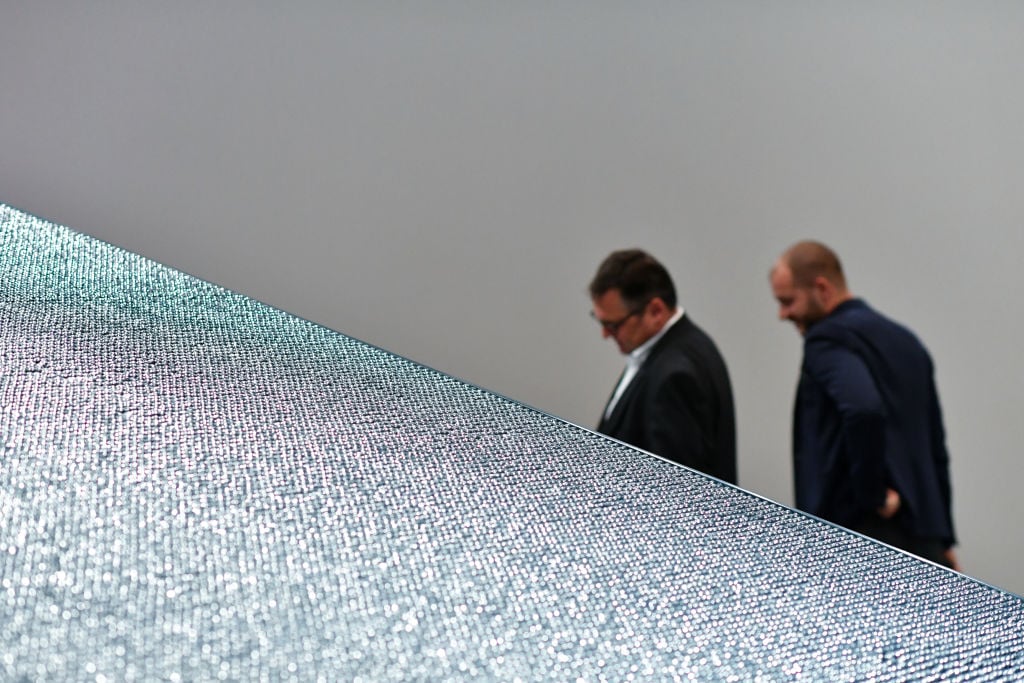
What does the global art market truly look like after a full year of near total shutdown, and practically no in-person art fairs? Art Basel’s annual report paints a stark picture.
Perhaps not surprisingly, the 2020 Art Market Report, compiled by economist Clare McAndrew, found that across the art industry and its related businesses, spending on fairs went from being the largest area of ancillary expenditure (at 24 percent in 2019), to just 10 percent of the total in 2020.
Dealers and auction houses diverted more resources to IT, with spending up by 80 percent year-on-year to $3.5 billion, the largest slice of ancillary spending.
For all the talk of robust online viewing rooms and hybrid auctions, with sales reportedly doubling in 2020, all market segments “experienced declines last year, creating the biggest recession in the global art market since the financial crisis of 2009,” Art Basel Americas director Noah Horowitz writes in the introduction to the study.
Art Basel 2019. Photo by FABRICE COFFRINI / AFP via Getty Images.
Global sales of art and antiques reached an estimated $50.1 billion in 2020, down 22 percent from 2019, while online sales reached a record high of $12.4 billion, double the value of the previous year. Those sales accounted for a record share of 25 percent of the market’s value.
Although the three major art hubs—the US, the UK, and China—saw a decline in transactions, they continued to account for a majority of global sales by value in 2020, at 82 percent. The US retained its leading position with a share of 42 percent, with China and the UK on par at 20 percent.
With respect to dealers, the fallout from the pandemic weighed on overall sales, with values declining by 20 percent to an estimated $29.3 billion in 2020, as compared with a slight uptick of two percent in 2019.
But with reduced operating costs, some galleries were still making money. The report found that 28 percent of dealers were more profitable than in 2019, and 18 percent said they maintained a stable level of net profit.
Dealers’ top priorities shifted noticeably in the past year, with most focusing on their existing clients, online sales, and cost-cutting. Most dealers (58 percent) said they expected an improvement in sales in 2021, while 27 percent predicted they would be stagnant, and 15 percent expected a further decline. The size of dealers’ client bases decreased to an average of 55 individual clients, compared with 64 in 2019.
A salesroom at Sotheby’s. Photo courtesy Sotheby’s.
Meanwhile, in the auction world, sales of fine art, decorative art, and antiques (excluding private sales) were $17.6 billion in 2020, down 30 percent from 2019. Private sales were “conservatively” estimated to have reached over $3.2 billion in 2020, up 36 percent compared with 2019. Total sales conducted by auction houses, including both public and private, are estimated to have reached $20.8 billion in 2020.
Notably, China overtook the US to become the largest auction market, with a share of 36 percent. The US accounted for 29 percent, and the UK 16 percent. According to the report, the largest sector of the fine art auction market by value was Postwar and contemporary art, at 55 percent, which, along with Modern art, accounted for just over 81 percent of the sales by value.
Sales in the Impressionist and Post-Impressionist sector, the dominant category 30 years ago, showed the largest decline in value between 2019 and 2020, with sales down over 50 percent.
In-person fairs, of course, suffered the greatest setbacks. Of 365 global art fairs planned for 2020, 61 percent were canceled and 37 percent held live events, while two percent held hybrid in-person/online events. A survey of 138 art fairs revealed that the majority (62 percent) offered a digital version of their fairs in 2020.
Frieze London 2019. Photo by Linda Nylind. Courtesy of Linda Nylind/Frieze.
The share of live art-fair sales declined dramatically in 2020 to just 13 percent of dealers’ total sales. Despite the high number of events being canceled, 41 percent of the high-net-worth (HNW) collectors surveyed reported that they made a purchase at a fair in 2020, while 45 percent reported making an acquisition through an art fair’s online viewing room.
Just under half of the HNW collectors surveyed said they would be willing to go to an art fair in the first six months of 2021, although 64 percent said they would be ready to attend local events. The majority of collectors (68 percent) said they would be happy to attend any fair by the end of Q3 2021, a number that rose to over 80 percent for the fourth quarter of the year.
Meanwhile, dealers at all levels showed significant increases in online sales, with the largest advance by those in the $10 million-plus turnover segment, to 47 percent. In the fine art auction sector, 22 percent of the lots sold in 2020 were online-only, double the share of 2019.
Works priced over $1 million made up only 6 percent of total online values, versus 58 percent for offline sales. Of HNW collectors, 90 percent visited an art fair or gallery online in 2020, and 72 percent said it was important or “essential” to have a price posted when browsing works of art for sale online.
Lastly, the report’s survey of 2,569 HNW collectors, conducted in conjunction with UBS bank, also yielded some notable insights, including that millennial HNW collectors were the highest spenders in 2020, with 30 percent having spent over $1 million, compared with 17 percent of Baby Boomers.